These TS 10th Class Biology Bits with Answers 8th Lesson Heredity and Evolution will help students to enhance their time management skills.
TS 10th Class Biology Bits 8th Lesson Heredity and Evolution
Choose the correct answer.
Question 1.
Palaentology deals with in ……………….
A) embryo
B) fossils
C) living seeds
D) fruits
Answer:
B) fossils
Question 2.
“The Origin of Species” was written by ……………
A) Charles Darwin
B) Jean Baptist Lamarck
C) Charles Lyell
D) Gregor Johann Mendel
Answer:
A) Charles Darwin
![]()
Question 3.
The scientist who studied on rats by cutting their tails is ………….
A) Darwin
B) Larnarck
C) Weisman
D) Meridel
Answer:
C) Weisman
Question 4.
The following diagrams are examples of …….

A) Analogous organs
B) Homologous organs
C) Catalogous organs
D) Anabolic organs
Answer:
B) Homologous organs
Question 5.
The wings of a bat and wings of a bird are an example of ….
A) Analogous organs
B) Vestigial organs
C) Hind limbs
D) Homologous organs
Answer:
A) Analogous organs
![]()
Question 6.
Which of the following is a correct statement?
A) Gene is a segment of DNA.
B) Gene is a segment of Endoplasmic Reticulum
C) Gene is a segment of Acetic acid.
D) Gene is a segment of Golgi complex.
Answer:
B) Gene is a segment of Endoplasmic Reticulum
Question 7.
The sex of a female child is determined by ……..
A) “X” chromosome in a sperm.
B) “X” chromosome in an ovum.
C) “Y” chromosome in an ovum.
D) “Y” chromosome in a sperm.
Answer:
A) “X” chromosome in a sperm.
Question 8.
In Mendel’s monohybrid cross, the phenotypic ratio in F2 generation is …………..
A) 2 : 1 : 1
B) 1 : 2 : 1
C) 3 : 1
D) 9 : 3 : 3 : 1
Answer:
C) 3 : 1
Question 9.
Identify the correct pair.
A) Gregor Johann Mendel — Law of segregation
B) Jean Baptiste Lamarck — Natural selection.
C) Charles Darwin — Inheritance of acquired characters.
D) August Weisitiann — Population theory.
Answer:
A) Gregor Johann Mendel — Law of segregation
![]()
Question 10.
Homologous organs means ………
A) Organs that are different in structure and perform the same functions.
B) Organs that are similar in structure and function.
C) Organs that differ in both structure and function.
D) Organs that are the similar in structure and perform different functions.
Answer:
D) Organs that are the similar in structure and perform different functions.
Question 11.
Who is known as father of ‘genetics’?
A) Mendel
B) Watson
C) Lamarck
D) Darwin
Answer:
A) Mendel
Question 12.
Mendel conducted his experiments on………….
A) Rose plant
B) Been plants
C) Pea plant
D) Mango trees
Answer:
C) Pea plant
Question 13.
Number of pairs of contrasting characters in pea plants selected by Mendel ……….
A) 3
B) 5
C) 7
D) 9
Answer:
C) 7
Question 14.
According to Mendel, this character is expressed in F1 generation [ ]
A) Dominant
B) Recessive
C) Both
D) None of these
Answer:
A) Dominant
![]()
Question 15.
In F2 generation, percentage of plants that exhibit dominant character is
A) 100%
B) 25%.
C) 50%
D) 75%
Answer:
D) 75%
Question 16.
The phenotype means …….
A) Externally visible characters
B) Internal characters
C) Changing characters
D) New characters
Answer:
A) Externally visible characters
Question 17.
‘Phenotype ratio’ of monohybrid cross is ………..
A) 1 : 2 : 1
B) 4 : 1
C) 3 : 1
D) 1 : 3 : 1
Answer:
C) 3 : 1
Question 18.
The ‘Genolype ratio’ of monohybrid cross is …………….
A) 1 : 2 : 1
B) 4 : 1
C) 3 : 1
D) 1 : 3 : 1
Answer:
A) 1 : 2 : 1
Question 19.
How many factors are responsible for producing a particular character or frail, according to Mendel? [ ]
A) 1
B) 2
C) 3
D) 4
Answer:
B) 2
![]()
Question 20.
If both the alleles are same for a character then it is said to be [ ]
A) Heterozygous
B) Homozygous
C) Mixed
D) None of these
Answer:
B) Homozygous
Question 21.
If the alleles are different for a character, then it is said to be …………….. [ ]
A) Heterozygous
B) Homozygous
C) Opposite
D) None of these
Answer:
A) Heterozygous
Question 22.
“One of the allele is dominant over other.” This law is known as [ ]
A) Law of segregation
B) Law of independent assortment
C) Law of dominance
D) Law of natural selection
Answer:
C) Law of dominance
Question 23.
“Each parent passes a randomly selected copy of only one of the alleles to an offspring” This law is known as ……
A) Law of natural selection
B) Law of dominance
C) Law of independent assortment
D) Law of segregation
Answer:
D) Law of segregation
Question 24
“Law of independent assortment”
A) Watson
B) Lamarck
C) Mendel
D) Darwin
Answer:
C) Mendel
Question 25.
Transmission of characters from parent to offspring is scientifically termed as ………. [ ]
A) Transmission
B) Heredity
C) Trait
D) Pass on
Answer:
B) Heredity
![]()
Question 26.
Factors or alleles of Mendel are now known us ……………
A) DNA
B) RINA
C) Genes
D) Nucleic acid
Answer:
C) Genes
Question 27.
Number of pairs of chromosomes in human beings ………..
A) 20
B) 21
C) 22
D) 23
Answer:
D) 23
Question 28.
Chromosomes whose number and morphology do not differ between males and females of a specks are called ……..
A) allosomes
B) autosomes
C) homosomes
D) heterosornes
Answer:
B) autosomes
Question 29.
Number of pairs of autosomes in human ……………..
A) 23
B) 1
C) 2
D) 22
Answer:
D) 22
Question 30.
Number of pairs of allosomes in humans ……..
A) 23
B) 1
C) 2
D) 22
Answer:
B) 1
Question 31.
Sex chromosomes in female human being ………
A) XX
B) XY
C) XZ
D) YY
Answer:
A) XX
Question 32.
Allosomes in male human being …………
A) XX
B) XY
C) ZX
D) YY
Answer:
B) XY
![]()
Question 33.
Gametes produced by woman have
A) Only X chromosomes
B) Only Y chromosomes
C) Both X and Y chromosomes
D) Any one of X or Y chromosome
Answer:
A) Only X chromosomes
Question 34.
Gametes produced by man have ……………………
A) Only X chromosomes
B) Only Y chromosomes
C) Both X and Y chromosomes
D) Any one of X or Y chromosome
Answer:
D) Any one of X or Y chromosome
Question 35.
If sperm with X chromosomes fertilizes the ovum, the baby will be [ ]
A) Boy
B) Girl
C) can not be decided
D) transgender
Answer:
B) Girl
Question 36.
If sperm with Y chromosome fertilizes the ovum, the baby will be …………..
A) Boy
B) Girl
C) Cannot be decided
D) Transgender
Answer:
A) Boy
Question 37.
Sex of the baby depends on…..[ ]
A) gamete from father
B) gamete from grandfather
C) gamete from mother
D) family history
Answer:
A) gamete from father
Question 38.
Variations in offspring are caused by [ ]
A) Sexual reproduction
B) Asexual reproduction
C) Errors in DNA copying
D) Both A & C
Answer:
D) Both A & C
![]()
Question 39.
Which of the following is a inherited trait?
A) Low weight due to starvation
B) Loss of body parts in accident
C) Height of the individual
D) Body growth due to exercise
Answer:
C) Height of the individual
Question 40.
Who is the first person to propose the theory of evolution? [ ]
A Mendel
B) Darwin
C) Lamarck
D) Weismann
Answer:
C) Lamarck
Question 41.
The theory proposed by Jean Baptist Lamarck ….. [ ]
A) Maithus theory
B) Natural selection
C) Inheritance of acquired characters
D) Survival of the fittest
Answer:
C) Inheritance of acquired characters
Question 42.
The scientist who disproved the theory of inheritance of acquired characters [ ]
A) Lamarck
B) Weismann
C) Darwin
D) Mendel
Answer:
B) Weismann
Question 43.
Augustus Weismann conducted his experiments on ………. [ ]
A) Cats
B) Rats
C) Dogs
D) Giraffe
Answer:
B) Rats
Question 44.
Who proposed the theory of natural selection? [ ]
A) Lamarck
B) Weismann
C) Darwin
D) Mendel
Answer:
C) Darwin
![]()
Question 45.
Name of the ship in which Charles Darwin voyaged [ ]
A) Titanic
B) HMS Eagle
C) HBS Beagle
D) HMS Beagle
Answer:
D) HMS Beagle
Question 46.
Finch birds observed by Darwin in this place [ ]
A) Galapagous islands
B) Indonesian islands
C) Anclaman islands
D) Maldives.
Answer:
A) Galapagous islands
Question 47.
The book “Principlèš of Geaogy”. was written by …. [ ]
A) Charles Lyell
B) Charles Darwin
C) Jean Baptist Lamarck
D) Maithus
Answer:
A) Charles Lyell
Question 48.
Forelimb of whale is for swimming where as in horse it is for [ ]
A) Flying
B) Digging
C) Running
D) Grasping
Answer:
C) Running
Question 49.
The continent from where Homosapiens came [ ]
A) America
B) Asia
C) Africa
D) Australia
Answer:
C) Africa
![]()
Question 50.
Wing of bat and claw of mole are the examples for [ ]
A) homologous organs
B) analogous organs
C) vestigial organs
D) all the above
Answer:
A) homologous organs
Question 51.
Wing of bird and wing of bat are the examples for…………. [ ]
A) homologous organs
B) analogous organs
C) vestigial organs
D) none of these
Answer:
B) analogous organs
Question 52.
……. are evidences of ancient life forms. [ ]
A) Homologous organs
B) Analogous organs
C) Fossils
D) Vestigial organs
Answer:
C) Fossils
Question 53.
The study of the development of an organism from egg to adult stage is called [ ]
A) Embryology
B) Palaeontolgy
C) Geology
D) Zoology
Answer:
A) Embryology
Question 54.
The study of fossil is called ….. [ ]
A) Embryology
B) Palaeontology
C) Ecology
D) Anatomy
Answer:
B) Palaeontology
Question 55.
Palaeontologists determine the age of fossil using …………. [ ]
A) Hydrogen dating
B) Nitrogen dating
C) Oxygen dating
D) Carbon dating
Answer:
D) Carbon dating
![]()
Question 56.
Fossils of the dinosaurs, ketosaurs are collected from this district in telangana. [ ]
A) Mahaboob Nagar district
B) Adilabad district
C) Medak district
D) Krishna district
Answer:
B) Adilabad district
Question 57.
Early man like forms appeared about …… years ago. [ ]
A) 7,50,000
B) 2,50,000
C) 1,50,000
D) 50,000
Answer:
A) 7,50,000
Question 58.
Homosaplens appeared about ………… years ago.
A) 1.8 million
B) 10,000
C) 3,00,000
D) 2.5 million
Answer:
B) 10,000
Question 59.
The factors responsible for character and units of heredity are [ ]
A) Variations
B) Genes
C) Fossils
D) Gametes
Answer:
B) Genes
Question 60.
Organs which are not useful in animal are called [ ]
A) Homologous organs
B) Analogous organs
C) Vestigial organs
D) Digestive organs
Answer:
C) Vestigial organs
Question 61.
There are nearly…… vestigial organs in human beings.
A) 110
B) 1
C) 180
D) 7
Answer:
C) 180
Question 62.
Which of the following is not a vestigial organ in human beings ?
A) pinna
B) hair on skin
C) thumb
D) appendix
Answer:
C) thumb
![]()
Question 63.
The process of acquiring change is …………
A) Adaptation
B) Evolution
C) Heredity
D) Mutation
Answer:
B) Evolution
Question 64.
Mendel experiment stands for ……
A) Heredity
B) Variations
C) Evolution
D) Mutation
Answer:
A) Heredity
Question 65.
The four characters observed in the experiments on law of independent assortment are [ ]
A) Round and Yellow
B) Wrinkled and green
C) Wrinkled and yellow
D) A and B only
Answer:
D) A and B only
Question 66.
TT or YY,YT or Yy are responsible for which character? [ ]
A) Recessive
B) Aggressive
C) Dominant
D) Independent
Answer:
C) Dominant
Question 67.
Female baby having 23 pairs of autosomes at the age of 18 years, has how many pairs of autosomes and of sex chromosomes?
A) 22 pairs of autosomes and 1 pair of sex chromosomes
B) 20 pairs of autosomes and 3 pairs of sex chromosomes
C) 22 pairs of sex chromosomes and 1 pair of autosomes
D) 20 pairs of sex chromosomes and 3 pairs of autosomes
Answer:
A) 22 pairs of autosomes and 1 pair of sex chromosomes
Question 68.
The progression in population growth is [ ]
A) Geometrical
B) Arithmetic
C) Mathematical
D) None of the above
Answer:
A) Geometrical
![]()
Question 69.
The progress in food sources growth is [ ]
A) Geometrical
B) Arithmetic
C) Mathematical
D) None of the above
Answer:
B) Arithmetic
Question 70.
A goat which walks properly cannot, live for a long time. According to Darwin, this represents [ ]
A) Natural selection
B) Inheritance of acquired characters
C) Survival of the fittest
D) All the above
Answer:
D) All the above
Question 71.
Forelimb of whale is for swimming whereas in horse it is used for [ ]
A) Running
B) Wailcing
C) Jumping
D) All the above
Answer:
D) All the above
Question 72.
Variations are
A) Differences in characters within very closely related groups of organisms
B) Similarities in characters within very closely related groups of organisms
C) Differences in characters within non-related groups of organisms
D) Similarities in characters within non-related groups of organisms
Answer:
A) Differences in characters within very closely related groups of organisms
Question 73.
When a pure yellow seed plant crosses with a pure green seed plant in F, generation, all the seeds are
A) Yellow
B) Green
C) Mixed coloured seeds
D) 75% yellow, 25% green
Answer:
A) Yellow
Question 74.
Identify the genotype ratio of mono hybrid cross.
A) 3 : 1
B) 1 : 2 : 1
C) 9 : 3 : 3 : 1
D) 1 : 3
Answer:
B) 1 : 2 : 1
Question 75.
The factor which expresses itself in the F1 generation is [ ]
A) Recessive
B) Expressive
C) Dominant
D) All the above
Answer:
C) Dominant
![]()
Question 76.
Identify the phenotype ratio of dihybrid cross. [ ]
A) 3 : 1
B) 1 : 2 : 1
C) 1 : 3
D) 9 : 3 : 3 : 1
Answer:
D) 9 : 3 : 3 : 1
Question 77.
The law of segregation explains
A) One of the alleles is dominant over other
B) Only one of the two factors for a character will pass from parent to offspring
C) The factors for each pair of characters assorted independently of the other pair
D) The factors for each pair of characters will pass from parent to of spring.
Answer:
B) Only one of the two factors for a character will pass from parent to offspring
Question 78.
Heredity is [ ]
A) Transmission of characters from parents to offsprings
B) Transmission of characters from offsprings to parents
C) Transmission of characters from male parent to offsprings
D) Transmission of characters from female parent to offsprings
Answer:
A) Transmission of characters from parents to offsprings
Question 79.
The process in which traits are passed from one generation to another generation is called [ ]
A) Variations
B) Inheritence
C) Genetic drift
D) None of the above
Answer:
B) Inheritence
Question 80.
Who hypothesised that each character is expressed due to a pair of factors or alleles? [ ]
A) Lamarck
B) Weismann
C) Mendel
D) Malthus
Answer:
C) Mendel
Question 81.
Segments of Deoxyribonucleic acid are called [ ]
A) Factors
B) Characters
C) Traits
D) Genes
Answer:
D) Genes
Question 82.
The expression of trait or character are controlled by [ ]
A) Genes
B) Factors
C) Both Genes and Factors
D) None
Answer:
A) Genes
Question 83.
Number of chromosomes present in each human cell [ ]
A) 44
B) 46
C) 42
D) 40
Answer:
B) 46
Question 84.
Chromosomes whose number and morphology do not differ between males and females of a species are called [ ]
A) Autosomes
B) Allosomes
C) Mesosomes
D) Centrosomes
Answer:
A) Autosomes
![]()
Question 85.
The baby will be boy if [ ]
A) The sperm carries Y chromosome fertilizes the ovum
B) The sperm carries X chromosome fertilizes the ovum
C) The sperm carries Y chromosome fertilizes the ovum with Y chromo some
D) The sperm fertilizes the ovum
Answer:
A) The sperm carries Y chromosome fertilizes the ovum
Question 86.
Variations develop during sexual reproduction occurs due to this in melotic division
A) Genetic drift
B) Genetic recombination
C) Mutations
D) All of the above
Answer:
B) Genetic recombination
Question 87.
Change in frequency of genes in small populations is known as [ ]
A) Genetic drift
B) Crossing over
C) Mutations
D) Genetic recombination
Answer:
A) Genetic drift
Question 88.
Change in these tissues cannot be passed onto the DNA of the germ cell [ ]
A) Reproductive tissue
B) Non- reproductive tissues
C) Non somatic tissue
D) All the above
Answer:
B) Non- reproductive tissues
Question 89.
Acquired characters are characters [ ]
A) Developed during lifetime of an organism
B) That comes from birth
C) That are present in forefathers
D) Present in F1 generation offsprings
Answer:
A) Developed during lifetime of an organism
Question 90.
‘Inheritance of acquired characters’ was proposed by [ ]
A) Lamarck
B) Darwin
C) Weismann
D) Mendel
Answer:
A) Lamarck
Question 91.
Elongation of neck and forelimbs in giraffes is an example for [ ]
A) Survival of the fittest
B) Inheritance of acquired characters
C) Natural selection
D) All the above
Answer:
B) Inheritance of acquired characters
Question 92.
Who tested the theory of inheritance of acquired characters by his experiments on rats for 22 generations?
A) Darwin
B) Hugo devries
C) August Weismann
D) Virchow
Answer:
C) August Weismann
Question 93.
August Weismann proved that bodily changes [ ]
A) Passed to its offsprings
B) Won’t be passed to its offsprings
C) Passed to its F2 generation offsprings
D) None of the above
Answer:
B) Won’t be passed to its offsprings
Question 94.
The birds identified by Darwin in Galapagous islands [ ]
A) Parrots
B) Doves
C) Eagles
D) Finch birds
Answer:
D) Finch birds
Question 95.
Darwin was influenced by the book “Principles of Geology” written by Sir [ ]
A) August Weismann
B) Lamarck
C) Charles Lyell
D) Haeckel
Answer:
C) Charles Lyell
Question 96.
Who felt that large changes occurred due to accumulation of small changes?
A) Charles Darwin
B) Lamarck II
C) Weismann
D) Charles Lyell
Answer:
A) Charles Darwin
![]()
Question 97.
In the struggle for existence only the fittest can survive. This is known as [ ]
A) Natural selection
B) Survival of the fittest
C) Law of segregation
D) Law of dominance
Answer:
B) Survival of the fittest
Question 98.
Who concluded that natural selection contributed to arising of new species?
A) Alfred Russel Wallace
B) August Weismann
C) Jean Baptist Lamarck
D) Malthus
Answer:
A) Alfred Russel Wallace
Question 99
Small changes within the species are known as [ ]
A) Macro evolution
B) Ecoevolution
C) Micro evolution
D) Bio evolution
Answer:
C) Micro evolution
Question 100.
Macro evolution is [ ]
A) The process of species formation
B) The process of genus formation
C)The process of formation of family
D) The process of formation of order
Answer:
A) The process of species formation
Question 101.
Forelimb of bat is for flying whereas in mole it is used for [ ]
A) Digging
B) Cutting
C) Chewing
D) Jumping
Answer:
A) Digging
Question 102.
Organs with common pattern in arrangement of bones, even though their external form and functions are different are called …… [ ]
A) Heterologous organs
B) Homologous organs
C) Vestigial organs
D) Digestive organs
Answer:
B) Homologous organs
Question 103.
Evolution of homologous organs is called [ ]
A) Divergent evolution
B) Convergent evolution
C) Resergent evolution .
D) Recessive evolution
Answer:
A) Divergent evolution
Question 104.
Organs which are structurally different but functionally similar are known as ……….
A) Vestigial organs [ ]
B) Homologous organs
C) Analogous organs
D) judicial organs
Answer:
C) Analogous organs
Question 105.
Evolution of analogous organs is called ………….
A) Divergent evolution
B) Convergent evolution
C) Resergent evolution
D) Recessive evolution
Answer:
B) Convergent evolution
Question 106.
These are evidences of ancient life forms :
A) Vestigial organs
B) Measles
C) Fossils
D) All the above
Answer:
C) Fossils
![]()
Question 107.
Carbon dating is used to determine the age of [ ]
A) Fossils
B) Living animals
C) Dead animals
D) Human beings
Answer:
A) Fossils
Question 108.
Appendix is the vestigial organ in human being but useful for [ ]
A) Monkey
B) Rabbit
C) Crocodile
D) Alligator
Answer:
B) Rabbit
Question 109.
Who are said to be a moving museum of vestigial organs? [ ]
A) Human being
B) Monkey
C) Elephant
D) Tiger
Answer:
A) Human being
Question 110.
Genetic drift provides [ ]
A) Evolution in the population
B) Diversity in the population
C) Convergency in the population
D) None of the above
Answer:
B) Diversity in the population
Question 111.
Which type of variation is inherited?
A) Somatic variation
B) Germinal variation
C) Both somatic and germinal variation
D) None
Answer:
B) Germinal variation
Question 112.
A trait in an offspring is influenced by [ ]
A) DNA of mother gamete
B) DNA of father gamete
C) Both DNAs of mother and father gamete
D) Neither of mother nor father gamete of DNA
Answer:
C) Both DNAs of mother and father gamete
Question 113.
On crossing Tall plant with Dwarf plant Mendel found the ratio of Dwarf plants in F2 generation was [ ]
A) 25%
B) 40%
C) 60%
D) 75%
Answer:
A) 25%
Question 114.
Analogous organs are [ ]
A) Wing of whale and wing of bat
B) Wings of butterfly, hat and bird
C) Aves and reptiles
D) All the above
Answer:
B) Wings of butterfly, hat and bird
Question 115.
In Galapagos islands, Darwin observed variations in structure in [ ]
A) Elephants
B) Giraffes
C) Rats
D) Finch birds
Answer:
D) Finch birds
![]()
Question 116.
The following body parts are examples for ………..

Forelimb of a whale Wing of a bat
A) Homologous Organs
B) Analogous organs
C) Haemophilic organs
D) None of the above
Answer:
A) Homologous Organs
Question 117.
Offsprings of first-generation parents are called [ ]
A) F1 generation
B) F2 generation
C) F3 generation
D) All the above
Answer:
A) F1 generation
Question 118.
The vitamins present in pea plant are [ ]
A) A, D, E, K
B) A, C, E, K and B
C) B, C, D, K
D) A, C, D and K
Answer:
B) A, C, E, K and B
Question 119.
Pea contains minerals like [ ]
A) Ca, Fe, Mg
B) Mn, P
C) S and Zn
D) All the above
Answer:
D) All the above
Question 120.
Monohybrid cross phenotype ratio is
A) 1 : 2 : 1
B) 4 : 1
C) 3 : 1
D) 1 : 3 : 1
Answer:
C) 3 : 1
Question 121.
Externally visible characters are called …………
A) Genotype
B) Phenotype
C) Homozygous
D) Heterozygous
Answer:
B) Phenotype
Question 122.
Charles Lye!! wrote a book called [ ]
A) Origin of Species
B) Journal of Linnaean Society
C) Principles of Geology
D) None of the above
Answer:
C) Principles of Geology
Question 123.
The scientist who studies fossil evidences is called [ ]
A) Geologist
B) Palaeontologist
C) Botanist
D) Chemist
Answer:
B) Palaeontologist
Question 124.
The theory of inheritance of acquired characters is disproved by [ ]
A) Weismann
B) Lamarck
C) Mendel
D) Darwin
Answer:
A) Weismann
Question 125.
Embryology is the study of ………….
A) Fossils
B) Development from egg to adult
C) Classification
D) Evolution
Answer:
B) Development from egg to adult
Question 126.
The theory of natural selection was proposed by [ ]
A) Lamarck
B) Weismann
C) Mendel
D) Darwin
Answer:
D) Darwin
Question 127.
Charles Darwin wrote a book called [ ]
A) Inheritance of Acquired Characters
B) Principles of Population
C) Origin of Species
D) Palaeontology
Answer:
C) Origin of Species
Question 128.
Monohybrid cross genotype ratio is
A) 1 : 2 : 1
B) 4 : 1
C) 3 : 1
D) 1 : 3 : 1
Answer:
A) 1 : 2 : 1
Question 129.
The character which is not inherited [ ]
A) Shape of nose
B) Colour of skin
C) Shape of ear lobes
D) Size of the body
Answer:
D) Size of the body
Question 130.
The dihybrid cross of phenotype ratio is [ ]
A) 9 : 3 : 3 : 1
B) 9 : 1 : 3 : 3
C) 3 : 3 : 1 : 9
D) 1 : 3 : 9 : 3
Answer:
A) 9 : 3 : 3 : 1
![]()
Question 131.
Acquiring change is called [ ]
A) Heredity
B) inheritance
C) Evolution
D) Speciation
Answer:
C) Evolution
Question 132.
Dominant characters are [ ]
A) TT or YY
B) T tor Ty
C) tt or yy
D) Both A & B
Answer:
C) tt or yy
Question 133.
“Journal of Linnaean Society” about natural selection was published by [ ]
A) Charles Darwin and Charles Lyell
B) Augustus Weismann and Charles Lyell
C) Charles Darwin and Alfred Russet
D) Hugo Devries and Augustus Weismann
Answer:
C) Charles Darwin and Alfred Russet
Question 134.
Find the missed one.
| Scientist | Proposed theory |
| 1. Darwin 2. August Weismann |
Natural selection ? |
A) Genetic laws
B) Inheritance of acquired characters
C) Speciation
D) Gerinpiasm theory
Answer:
D) Gerinpiasm theory
Question 135.
Complete the flowchart.

A) Rats
B) Dog
C) Pea plants
D) Giraffee
Answer:
D) Giraffee
Question 136.
Find the missed one.
| Book | Scientist |
| The Origin of Species An Essay on the Principles of population. |
Charles Darwin ? |
A) Wallace
B) Lamarck
C) Weismann
D) Maithus
Answer:
D) Maithus
Question 137.
HMS Beagle : Charles Darwin, Indonesian islands : ……. ?……. [ ]
A) Lamarck
B) Maithus
C) Charles Lyell
D) AR Wallace
Answer:
D) AR Wallace
Question 138.
Kangaroo : Australia : : First Man:… ?…
A) Asia
B) Europe
C) North America
D) Africa
Answer:
D) Africa
Question 139.
Match the following.
List – A —- List – B
1. Finch birds ( ) a) Fossils of ketosaurs
2. Yamariapalli ( ) b) August Weismann
3. Rats( ) c) Galapagos islands
A) 1 – c, 2 – b, 3 – a
B) 1 – a, 2 – c, 3 – b
C) 1 – a, 2 – b, 3 – c
D) 1 – c, 2 – a, 3 – b
Answer:
D) 1 – c, 2 – a, 3 – b
Question 140.
Identify the mismatched pair [ ]
1. Connecting link — Dinosaur
2. Homosapiens — Gorilla
3. Evolution — Process of attaining changes
A) 1, 3
B) 2, 3
C) 2 only
D) 1, 2
Answer:
D) 1, 2
![]()
Question 141.
Match the following.
List-A —– List-B
1. Allosomes in male ( ) — a) XX
2. Allosomes in female ( ) — b) Genes
3. Factors ( ) — c) XY
A) 1 – a, 2 – b, 3 – c
B) 1 – a, 2 – c, 3 – b
C) 1 – c, 2 – b, 3 – a
D) 1 – c, 2 – a , 3 – b
Answer:
D) 1 – c, 2 – a , 3 – b
Question 142.
Darwin : Finch birds : : Mendel:
A) Giraffee
B) Pea plants
C) Rats
D) Cats
Answer:
B) Pea plants
Question 143.
Variations in offsprings are caused by [ ]
A) Sexual reproduction
B) Asexual reproduction
C) Errors in DNA Mapping
D) Both A and C
Answer:
D) Both A and C
Question 144.
“Survival of the fittest” is associated with [ ]
A) Lamarck
B) August Weismann
C) Darwin
D) Mendel
Answer:
C) Darwin
![]()
Question 145.
Match the following. [ ]
1. Vestigial organ ( ) a) Human forelimb – Bird wing
2. Analogous organ ( ) b) Wings of the bat – wings of the bird
3. Homologous organ ( ) c) Appendix
A) 1 – a, 2 – b, 3 – c
B) 1 – a, 2 – c, 3 – h
C) 1 – b, 2 – c, 3 – a
D) 1 – c, 2 – b, 3 – a
Answer:
D) 1 – c, 2 – b, 3 – a
Question 146.
Identify the mismatched pair. [ ]
1. Zoogeography – Speciation
2. Genetics – Study of heredity
3. Eibryology – Study of fossils
A) 1, 2
B) 2 only
C) 1 only
D) 3 only
Answer:
D) 3 only
Question 147.
Identify the mismatched pair.
1. Pheñotypic ratio of F, generation – 1 : 2 : 1
2. Genotypic ratio of F2 generation – 3 : 1
3. Phenotypicrtio of Dihybrid cross – 9 : 3 : 3 : 1
A) 1, 3
B) 2, 3
C) 2 only
D) 1, 2
Answer:
D) 1, 2
Question 148.
The genotypic ratio of the checker board is ……………….
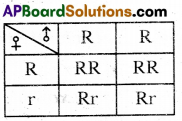
A) 2 : 0
B) 1 : 2 : 0
C) 2 : 1
D) 1 : 1 : 0
Answer:
D) 1 : 1 : 0
![]()
Question 149.
Find the odd man out. ( )
A) Appendix
B) Hair on skin
C) Pinna
D) Thumb
Answer:
D) Thumb
Question 150.
Palaeontology : fossils : :
Anthropology: …………?……………..
A) Speciation
B) Evolution
C) Genes
D) Study of human race
Answer:
D) Study of human race
Question 151.
An injured deer in a forest was chased away easily hunted by a tiger. According to Darwinsirn, this represents
A) Natural Leon.
B) Struggle for existence
C) Survival of the fittest
D) All of the above
Answer:
C) Survival of the fittest
Question 152.
Thousands of contestants are preparing for the examinations to get a job. According to Darwinism, this represents [ ]
A) Natural selection
B) Survival of the fittest
C) Struggle for existence
D) All the above
Answer:
C) Struggle for existence
Question 153.
On crossing tall plant with dwarf plant, Mendel found the ratio of dwarf plant F2 generation was [ ]
A) 40%
B) 60%
C) 75%
D) 25%
Answer:
D) 25%
Question 154.
Can you identify this great scientist?

A) Darwin
B) Sutton
C) Crick
D) Mendel
Answer:
D) Mendel
Question 155.
Can you name the structure present in the given figure?

A) Nucleus
B) Cell
C) Nucleolus
D) DNA
Answer:
D) Mendel
![]()
Question 156.
Identify these two great scientists associated with genetics.

A) Sutton & Boweri
B) Watson & Crick
C) Franklin & Wilkins
D) Scheldon & Schwann
Answer:
B) Watson & Crick
Question 157.
This diagram is associated with [ ]
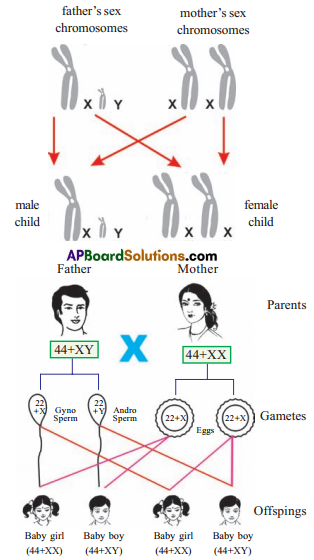
A) Genetic mapping
B) Sex linked inheritance
C) Sex determination
D) Mutations
Answer:
C) Sex determination
![]()
Question 158.
This picture is associated with [ ]

A) Mutations
B) Somatic variations
C) Genetic variations
D) Evolution
Answer:
C) Genetic variations
Question 159.
This figure is associated with [ ]

A) Mutations
B) Somatic variations
C) Genetic variations
D) Evolution
Answer:
B) Somatic variations
Question 160.
This animal is associated with the following scientist. [ ]
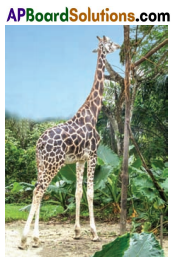
A) Darwin
B) Lamarck
C) August Weismann
D) A.R.Wallace
Answer:
B) Lamarck
Question 161.
These are best example for [ ]

A) Acquired characters
B) Gerrnplasm theory
C) Natural selection
D) Mutations
Answer:
C) Natural selection
Question 162.
The famous scientist shown in the given figure, wrote a book called “The Origin of Species” is [ ]
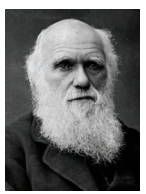
A) Lamarck
B) AR Wallace
C) Darwin
D) Mendel
Answer:
C) Darwin
![]()
Question 163.
This scientist made his studies on natural selection in these islands [ ]

A) Galapagos
B) Medagascar
C) Malasian islands
D) Indonesian islancis
Answer:
D) Indonesian islancis
Question 164.
These are best examples for [ ]
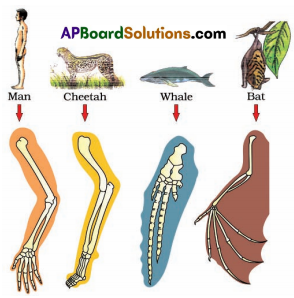
A) Analogus organs
B) Hornologus organs
C) Vestigial organs
D) Fossils
Answer:
B) Hornologus organs
Question 165.
These are best examples for [ ]

A) Homologus organs
B) Analogus organs
C) Vestigial organs
D) Fossils
Answer:
B) Analogus organs
Question 166.
The branch of science that deals with the study of the above structures in the figure [ ]

A) Palaeontology
B) Biochemistry
C) Anthropology
D) Embryology
Answer:
D) Embryology
Question 167.
This is the fossil of [ ]

A) Archeopteryx
B) Ketosaurs
C) Giraf fee
D) Flying
Answer:
B) Ketosaurs
![]()
Question 168.
Can you identify this extinct connecting link. [ ]
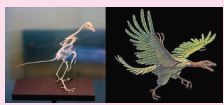
A) Dinosaur
B) Ketosaur
C) Archeopteryx
D) Flying snake
Answer:
C) Archeopteryx
![]()
Question 169.
The branch of science that deals with the study of the above figure [ ]

A) Embryology
B) Genetics
C) Palaeont logy
D) Anthropology
Answer:
D) Anthropology